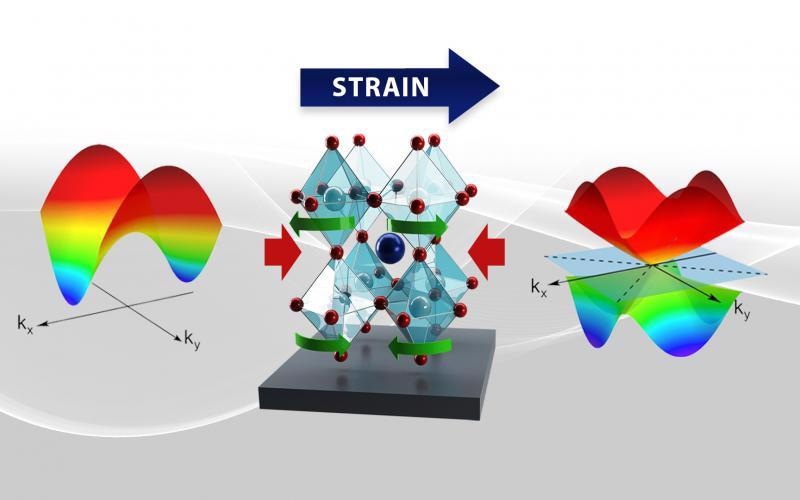Researchers at the U.S. Department of Energy’s Oak Ridge National Laboratory (ORNL) have succeeded in recreating correlated electron behavior in a strained perovskite oxide. This opens up the possibility of studying electron behavior at the extreme quantum limit and bodes well for future superconductor applications.

Image Credit: Correlated electrons ‘tango’ in a perovskite oxide at the extreme quantum limit. (2021). https://www.ornl.gov/news/correlated-electrons-tango-perovskite-oxide-extreme-quantum-limit
Extreme Quantum Limit in a Dirac Semimetal
Scientists have been debating the nature of the extreme quantum limit (EQL) for half a century. However, experiments have been difficult to achieve since, for conventional materials, the magnetic fields needed to achieve this state only occur inside neutron stars.
Electrons behave predictably in traditional materials - in insulators, they're under reactive, in conductors, they're highly reactive. However, in quantum materials, the interactions between the electrons increase substantially and they stop behaving like single particles.
They become entangled and start behaving in unexpected ways. It's a phenomenon Einstein dubbed ‘spooky action at a distance,’ where two objects affect each other's behavior, even across vast distances, and with no exchange of information.
However implausible, experiments have proven this.3 Principal investigators Jong Mok Ok and Ho Nyung Lee at ORNL plan to use this to model electron behaviors in superconductors.
Our goal is to understand what will happen when electrons enter the extreme quantum limit, where we find phenomena we still don’t understand.
Ho Nyung Lee, co-principal investigator, ORNL
Ok and his colleagues synthesized an exceptionally stable crystalline thin film made from strontium niobate (SrNbO3). They strained the material to condense the layers and stabilize a phase that is not found in the bulk crystal.
Straining the material creates an electronic band structure that facilitates highly correlated behavior between electrons. This effectively turns into a Dirac condensed matter system, with promising applications in transistors and superconductors. Ok and his team were the first to stabilize this phase.
A New Kind of Superconductor
Strontium niobate has already been identified as a high-performance superconducting material.4 It is unique in having conducting properties in both the visible and ultra-violet spectrum. It has promising applications in LEDs, photovoltaic cells and optical detectors.
Strontium niobate is a perovskite, a pseudocubic crystal first unearthed in Russia in 1839. As a Dirac condensed matter system, electrons in Strontium niobate are especially mobile. They could form the basis of a superconducting material. The challenge, however, is to preserve topology and correlated behavior.
Computer simulations have shown that, in the strained state, the compound alters its formation, generating a special symmetry with a novel electron band structure. Degenerate quantum states obtain identical energy values.
Dirac electrons may take any one of these values. So, this special symmetry creates four states (states of matter) at a single energy level.
Think of a quantum material under a magnetic field as a 10-story building with residents on each floor. Each floor is a defined, quantized energy level. Increasing the field strength is akin to pulling a fire alarm that drives all the residents down to the ground floor to meet at a safe place. In reality it drives all the Dirac electrons to a ground energy level called the extreme quantum limit.
Jong Mok Ok, co-principal investigator, ORNL
In theory, 100,000 Tesla are needed to coax electrons in traditional semiconductors towards the quantum limit. However, tests performed at the University of Florida's National High Magnetic Field Laboratory showed that only three Tesla were needed to reach the extreme quantum limit with the ORNL's perovskite oxide material.
Now, we can push all the electrons to this extreme quantum limit by applying only a few tesla of magnetic field in a lab, accelerating our understanding of quantum entanglement.
Jong Mok Ok, co-principal investigator, ORNL
These developments hold a lot of promise for quantum computing, semiconductors and superconductors in the future.
References and Further Reading
- Correlated electrons ‘tango’ in a perovskite oxide at the extreme quantum limit. (2021). https://www.ornl.gov/news/correlated-electrons-tango-perovskite-oxide-extreme-quantum-limit
- Mok Ok J., et al. (2021). Correlated oxide Dirac semimetal in the extreme quantum limit. https://www.science.org/doi/10.1126/sciadv.abf9631. DOI: 10.1126/sciadv.abf9631
- Merali, Z. (2015) Quantum ‘spookiness’ passes toughest test yet. https://www.nature.com/articles/nature.2015.18255
- Park, Y., Roth, J., Oka, D. et al. (2020). SrNbO3 as a transparent conductor in the visible and ultraviolet spectra. Commun Phys 3, 102. https://doi.org/10.1038/s42005-020-0372-9
Disclaimer: The views expressed here are those of the author expressed in their private capacity and do not necessarily represent the views of AZoM.com Limited T/A AZoNetwork the owner and operator of this website. This disclaimer forms part of the Terms and conditions of use of this website.